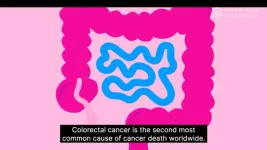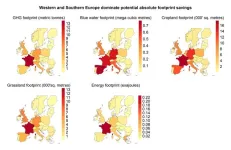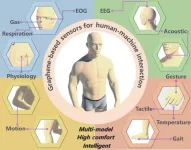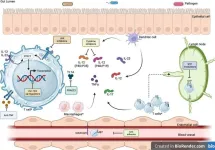(Press-News.org) BOSTON – In June 2022, the U.S. Supreme Court overruled Roe v. Wade, effectively ending 50 years of federal protections to abortion care. As of October 2023, twenty-six states have since enacted laws to ban or restrict abortion access, with 14 states completely banning the procedure. Today, an estimated 25 million American women of childbearing age, or about one third of women ages 15 to 45, live in areas where abortion care is severely restricted. Historically, many states were able to restrict access to abortion even before 2022 through Targeted Regulation of Abortion Providers (TRAP) laws; these laws decrease abortion volumes by legally limiting the number of abortion-providing facilities.
With more than 4 million children placed into foster care during the study period, researchers at Beth Israel Deaconess Medical Center (BIDMC) and Bentley University used state-level data to evaluate the link between restricted abortion access and subsequent entries into the foster care system. The findings, published in JAMA Pediatrics, reveal fewer children conceived in years when abortions were more accessible were subsequently placed into foster care. Conversely, first trimester pregnancy in a state with a TRAP law in place was associated with an overall 11 percent increase in children entering the foster care system.
“Limited access to abortion has significant personal impacts for the mothers and children affected, but also broader national economic and policy-level implications,” said senior author Ashley L. O’Donoghue, PhD, an economist in the Center for Healthcare Delivery Science at BIDMC. “With the repeal of Roe v. Wade, and many states already facing overburdened foster care systems, it is important to study the impact that restricted abortion access has on the foster care system to help inform future policy changes.”
To compare the number of children conceived between 1990-2011 and placed in foster care between 2000-2020 in states with and without TRAP laws, O’Donoghue and colleagues looked at the comprehensive Jones and Pineda-Torres data on state-level TRAP laws enacted since the 1970s and federal data from the Adoption and Foster Care Analysis and Reporting System. The team found an overall increase in foster care entries in states with restrictive abortion laws, compared to states without them, including a 15 percent increase for Black and racial and ethnic minority children in states with TRAP laws.
“Our findings highlight the complex interplay between race, socio-economic status and abortion, noting that those who are less able to provide for their children may be the most vulnerable when denied an abortion,” said O’Donoghue, who is also an instructor in medicine at Harvard Medical School. “Additionally, the race-specific findings are particularly salient. Policies that restrict abortion may contribute to the overrepresentation of racial and ethnic minority children in the foster care system, perpetuating inequities and further straining vulnerable populations.”
When the team compared states with TRAP laws to states without a decade before the laws’ enactment, they saw few differences in foster care entries. However, when they compared states with and without TRAP laws a decade after the laws were enacted, they saw the increases in children entering the foster care system persisted.
“The ripple effects are persistent for years after the TRAP law’s passage, resulting in lasting effects on foster care systems,” O’Donoghue said. “Our findings suggest that overturning Roe vs. Wade could have significant consequences for the foster care system and beyond in years to come.”
Co-authors included Noa Talmor, BS, Molly H. White, MS-ACMS, Caryn Dutton, MD, MS, and Ashley L. O’Donoghue, PhD of BIDMC and corresponding author Savannah Adkins, PhD, of Bentley University.
This work was not supported by any outside funding.
O’Donoghue serves as a volunteer case reviewer for the Massachusetts Department of Children & Families’ Foster Care Review Unit. Talmor works full-time at IQVIA, a health data company, within the Market Access Strategy Consulting division.
About Beth Israel Deaconess Medical Center
Beth Israel Deaconess Medical Center is a leading academic medical center, where extraordinary care is supported by high-quality education and research. BIDMC is a teaching affiliate of Harvard Medical School, and consistently ranks as a national leader among independent hospitals in National Institutes of Health funding. BIDMC is the official hospital of the Boston Red Sox.
Beth Israel Deaconess Medical Center is a part of Beth Israel Lahey Health, a health care system that brings together academic medical centers and teaching hospitals, community and specialty hospitals, more than 4,800 physicians and 38,000 employees in a shared mission to expand access to great care and advance the science and practice of medicine through groundbreaking research and education.
# # #
END
Multiple sclerosis patients whose blood tests reveal elevated NfL, a biomarker of nerve damage, could see worsening disability one to two years later, according to a new study spearheaded by researchers at UC San Francisco.
The study is the first to quantify the timeframe preceding disability worsening in which injury to the central nervous system takes place, said co-first author Ahmed Abdelhak, MD, of the UCSF Department of Neurology and the Weill Institute for Neurosciences.
Almost 1 million Americans ...
Article in Nature Communications demonstrates that with 96% sensitivity, AI diagnostic MSIntuit™ CRC can rule out almost half of the MSS population of colorectal cancer patients unlikely to respond to checkpoint inhibitor therapy from additional screening.
Such AI-enabled solutions have the potential to improve lab efficiency, addressing global pathology shortages and reducing testing burden to match the right patients to the right therapies.
Paris and New York., 6 Nov 2023 – In a peer-reviewed study published today in Nature Communications, a team of scientists ...
New research shows that European food consumption draws unnecessarily excessively on global resources, which is why researchers are calling for political action. Many of the foods that are consumed in Europe are produced in countries outside Europe. Food loss – and waste later in the chain, (read more on waste terms below) – occurs along the food supply chain, from the primary agricultural sector in Europe or rest of the world, until it feeds mouths in Europe.
“Halving Europe’s food loss and waste, together with a redistribution of global food resources, could solve the challenges of food shortages in the ...
A new virtual brain bank spanning five Chicago academic medical centers and led by University of Illinois Chicago will create a powerful new resource for clinical care and research on epilepsy, brain tumors and neurological disorders.
A $5 million grant from the National Institutes of Health will create a network of brain tissue research at UIC, Northwestern University, Lurie Children’s Hospital, Rush University and University of Chicago. The institutions will utilize a data platform developed at UIC called INTUITION that combines tissue data with clinical, functional, genetic and 3D imaging information to assist clinicians treating patients and help researchers better understand ...
Interaction between machines and humans is paramount to the development of the new technologies of the metaverse, which are designed to augment the human experience through cloud computing and extended reality (XR). Graphene, a two-dimensional carbon material, has emerged as an ideal candidate for wearable sensor technology, paving the way for a new era of seamless human-machine interaction (HMI).
A team of material scientists led by Tian-Ling Ren from Tsinghua University in Beijing, China recently outlined the state of graphene-based HMI sensor technology ...
Fatty liver diseases (FLD) have become a significant health concern worldwide, affecting millions. The two most common types of FLD are non-alcoholic fatty liver disease (NAFLD) and alcoholic-associated liver disease (ALD). NAFLD is associated with obesity, insulin resistance, and metabolic syndrome, while ALD is caused by excessive alcohol consumption. Both NAFLD and ALD can progress to liver fibrosis, cirrhosis, and, ultimately, hepatocellular carcinoma (HCC), a primary liver cancer with a poor prognosis.
Significant ...
Ulcerative colitis (UC) and Crohn's disease (CD) are chronic inflammatory bowel diseases (IBD) that affect the gastrointestinal tract. In recent decades, there have been significant advances in the understanding of IBD pathophysiology and the development of new treatments.
The International Organisation for the Study of Inflammatory Bowel Diseases (IOIBD) developed the Selecting Therapeutic Targets in Inflammatory Bowel Disease (STRIDE) programs, which recommend specific treatment goals for UC and CD in children ...
- A multicenter study of the MD Anderson, Korea University, Yonsei University, and other institutions
- Establishing subtypes of gastric cancer classification to lay the foundation of personalized treatment
Professor Sang Cheul Oh of the Division of Oncology/Hematology, Department of Internal Medicine, Korea University College of Medicine, Professor Sang‑Hee Kang of the Department of Surgery, Korea University’s Guro Hospital, and Professor Sun Young Yim of the Division of Gastroenterology and Hepatology, Department of Internal Medicine, Korea University College of Medicine announced a new genetic classification system ...
ABSTRACTS: 1534, 777, 1328, 1526, 1330, 545
HOUSTON ― The University of Texas MD Anderson Cancer Center’s Research Highlights provides a glimpse into recent basic, translational, and clinical cancer research from MD Anderson experts.
This special edition features oral presentations from the Society for Immunotherapy of Cancer (SITC) 38th Annual Meeting focused on scientific advances and breakthroughs in cancer immunotherapy from MD Anderson-led studies. Highlights include fecal microbiome transplants ...
LAWRENCE — The story of Ekgmowechashala, the final primate to inhabit North America before Homo sapiens or Clovis people, reads like a spaghetti western: A grizzled and mysterious loner, against the odds, ekes out an existence on the American Plains.
Except this tale unfolded about 30 million years ago, just after the Eocene-Oligocene transition during which North America saw great cooling and drying, making the continent less hospitable to warmth-loving primates.
Today, paleontologists from the University ...





